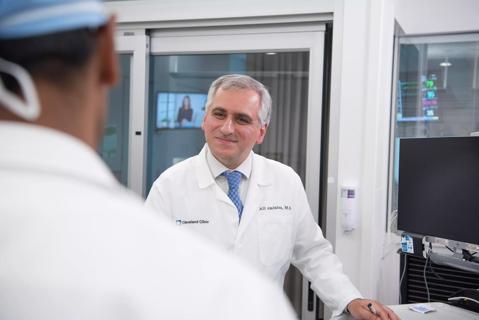A new study shows that an AI-enabled bundled system of sensors and coaching reduced A1C with fewer medications

More than 70% of people with type 2 diabetes (T2D) using a new lifestyle app that leverages artificial intelligence (AI) reduced their HbA1C to less than 6.5% and reduced or eliminated their glucose-lowering medications.
Advertisement
Cleveland Clinic is a non-profit academic medical center. Advertising on our site helps support our mission. We do not endorse non-Cleveland Clinic products or services. Policy
A randomized study of people with T2D compared 50 individuals receiving usual care (UC) to 100 who had an app on their phone that used personalized, real-time data to recommend food choices, physical activity, sleep and relaxation practices. The primary endpoint was the percentage of subjects achieving HbA1c <6.5% (<48 mmol/mol) without any glucose-lowering medications except metformin at 12 months.
The primary endpoint was met by 71% of those who used the lifestyle platform and only 2.4% of the UC group.
Published recently in NEJM Catalyst, "Type 2 Diabetes Pharmacotherapy De-escalation Through AI-enabled Lifestyle Modifications: A Randomized Clinical Trial” investigated Twin Precision Treatment (Twin Health, Mountain View CA), a commercially available system that incorporates data from a continuous glucose monitor (CGM) and an activity tracker, as well as artificial intelligence-machine learning (AI-ML) algorithms, laboratory data and human telecoaching, to prompt real-time effective lifestyle modifications in a personalized and user-friendly way.
The goal of the research was to determine whether the AI-enabled bundled system of sensors and health coaching could provide the support needed to help users sustain lifestyle changes sufficient to control their diabetes while de-escalating glucose-lowering medications.
“In routine clinical practice, T2D is often treated with a one-size-fits all approach where individuals are prescribed medications and told to ‘watch their diet and stay active,’ but not provided the counseling and tools necessary to do so,” said , Kevin Pantalone, DO, Cleveland Clinic endocrinologist, professor of medicine at Cleveland Clinic Lerner College of Medicine, and first author on the study. “By leveraging personalized lifestyle modifications to understand each patient’s unique metabolic profile, the tool enabled individuals to make impactful lifestyle choices. The results show that with the right tools, we can not only manage T2D more effectively but also reduce dependence on glucose-lowering medications.”
Advertisement
T2D is a widespread and growing global health issue, associated with serious medical complications and significant economic effects on individuals and society. According to the World Health Organization, the number of people living with diabetes rose from 200 million in 1990 to 830 million in 2022.
Traditional treatment approaches, which center on glucose control, presume that T2D requires progressive intensification of pharmacotherapy to achieve and maintain glycemic targets. Even with the availability of new glucose-lowering drugs and CGM technology, achieving and maintaining ideal glycemic levels remains a challenge. Managing the condition effectively requires consistent commitment to lifestyle changes and/or a medication regimen, and many patients find adherence difficult.
The Twin Precision Treatment system synthesizes data from multiple sources, including the Bluetooth-enabled wearable glucose and activity sensors, targeted laboratory analyses, internet-of-things connectivity, and AI-ML algorithms. By aggregating objective inputs and subjective patient preferences, the platform continuously generates and refines individualized recommendations.
Nutrition guidance is tailored through AI-ML models that predict postprandial glycemic responses to specific foods, which allows for a degree of precision that is difficult for individuals to achieve on their own. This methodology facilitates flexible, patient-guided dietary choices without the need for meal replacement regimens or extreme restrictions of calories or carbohydrates. Study participants were instructed to eat to satiation and not to limit meals based on caloric intake.
Advertisement
On the app, based on ongoing AI-ML modeling of individualized glycemic responses to specific meals, foods were color-coded: green=recommended, orange=eat in moderation, and red=discouraged. The app recommended "green" foods that also were preferred by the individual. Participants could use a bar code scanning feature in the app while grocery shopping to identify a food's color category.
"Relying on color-coded recommendations is so much easier for people than trying to use nutrition guides and food nutrition labels to determine percentages of carbohydrates and proteins," says Dr. Pantalone. "Patients really struggle with figuring out nutrition values in real-world settings. Access to simplified and personally tailored information through the app, and to frequent interactions with health coaches, empowered them in their decision making."
The app conveyed up to 15 updated recommendations a week. For 10 days, and afterward as needed, certified human health coaches added recommendations via daily chats using a secure texting platform within the app. Video calls took place at two weeks, and then at one, three, six, nine and 12 months.
Laboratory testing was performed at randomization and at one, three, six, nine and 12 months. Throughout the study, Metformin dosages were adjusted as appropriate. Licensed clinicians supervised CGM-guided changes to T2D medication regimens, including discontinuation.
The app initially set up a daily steps target of 5,000, gradually increasing to a goal of 7,000 steps or more. Participants also were encouraged to perform resistance training three times a week for 20 minutes.
Advertisement
In the study, participants using the digital platform received CGMs, the smart watch activity sensor, a smart scale and a blood pressure meter. In addition to following the app's food recommendations, they were encouraged to follow targets established for aerobic exercise and strength training.
Patient-reported quality-of-life and treatment satisfaction also improved among the digital-twin users, but not in those receiving usual care.
Participants' median age was 58.5 years; median diabetes duration was nine years; starting BMI was 35.1 kg/m2; and HbA1c was 7.2%. Twelve of the app users and two of the UC patients discontinued the study before the 12-month mark.
In addition to achieving the primary endpoint (71% for app users versus 2.4% for UC patients), mean changes in HbA1c and body weight from baseline to 12 months were also larger in the app users than in UC participants.
At 12 months, mean changes in HbA1C (-1.3% vs -0.3%) and body weight (-8.6% vs -4.6%) were significantly greater in the app users than in UC participants.
Analysis revealed significant decreases from baseline to 12 months in the use of the following glucose-lowering medications in the intervention group:
In contrast, corresponding percentages among UC participants using each medication class increased or changed very little from baseline to 12 months.
Advertisement
“Overall, our study demonstrated the AI-enabled, bundled system of sensors and coaching facilitated significant improvements in glycemic control, weight loss, and quality of life versus usual care, while allowing marked de-escalation of glucose-lowering pharmacotherapy,” says Dr. Pantalone. “Interventions like this system can help patients make informed, lasting lifestyle changes to control their blood sugar.”


Future research
In the future, there is an opportunity to study whether ideal A1C control can be sustained for longer periods of time with use of the technology-driven intervention and whether users can continue to use minimal glucose-reducing medications.
"In an era when AI and Bluetooth-enabled technology (including CGM) is opening up new possibilities for improving health and wellbeing, it's important that as clinicians, we resist stereotypes about who is and is not open to using technology, or who may or may not succeed using technology," says Dr. Pantalone. "Many patients with T2D are willing and even eager to engage with tech if it helps them control their blood sugar while also reducing their dependency on glucose-lowering therapies.
“Most of the participants in the intervention group remained engaged for the entire 12 months of the study, which affirms favorable usability and adaptation of this technology,” he adds. “The highly personalized feedback supplied them with evidence of their progress, which we believe reinforced adherence."
Advertisement

TRANSITION-T2D RCT results for patients with T2D receiving MDI

Provider vigilance and patient education are key for management

Findings could help clinicians make more informed decisions about medication recommendations

Observational evidence of neuroprotection with GLP-1 receptor agonists and SGLT-2 inhibitors

Consider each patient's unique disease progression and treatment goals when choosing a strategy

While results were negative for metformin, lifestyle counseling showed surprising promise

A weight-management program plus anti-obesity medication performs well

Largest, longest analysis to date shows greater weight loss and fewer diabetes medications needed